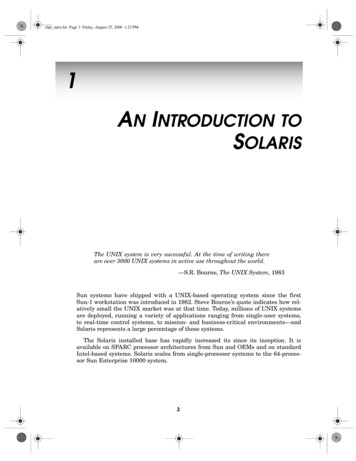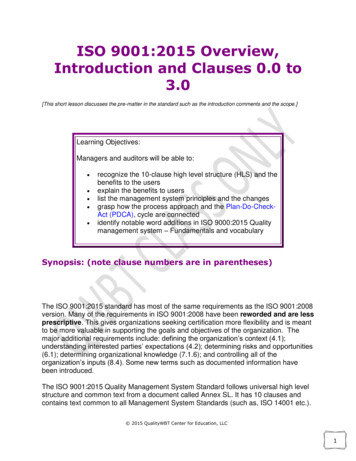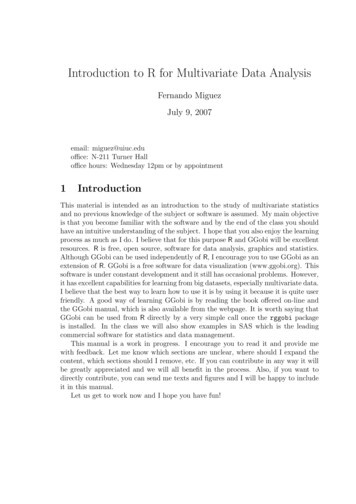
Transcription
chpt intro.fm Page 3 Friday, August 25, 2000 1:23 PM1AN INTRODUCTION TOSOLARISThe UNIX system is very successful. At the time of writing thereare over 3000 UNIX systems in active use throughout the world.—S.R. Bourne, The UNIX System, 1983Sun systems have shipped with a UNIX-based operating system since the firstSun-1 workstation was introduced in 1982. Steve Bourne’s quote indicates how relatively small the UNIX market was at that time. Today, millions of UNIX systemsare deployed, running a variety of applications ranging from single-user systems,to real-time control systems, to mission- and business-critical environments—andSolaris represents a large percentage of these systems.The Solaris installed base has rapidly increased its since its inception. It isavailable on SPARC processor architectures from Sun and OEMs and on standardIntel-based systems. Solaris scales from single-processor systems to the 64-processor Sun Enterprise 10000 system.3
chpt intro.fm Page 4 Friday, August 25, 2000 1:23 PM41.1An Introduction to SolarisA Brief HistorySun’s UNIX operating environment began life as a port of BSD UNIX to the Sun-1workstation. The early versions of Sun’s UNIX were known as SunOS, which is thename used for the core operating system component of Solaris.SunOS 1.0 was based on a port of BSD 4.1 from Berkeley labs in 1982. At thattime, SunOS was implemented on Sun’s Motorola 68000-based uniprocessor workstations. SunOS was small and compact, and the workstations had only a fewMIPS of processor speed and around one megabyte of memory.In the early to mid-1980s, networked UNIX systems were growing in popularity; networking was becoming ubiquitous and was a major part of Sun’s computingstrategy. Sun invested significant resources in developing technology that enableddistributed, network-based computing. These technologies included interfaces forbuilding distributed applications (remote procedure calls, or RPC), and operatingsystem facilities for the sharing of data over networks (Network Information System, or NIS) and a distributed computing file system: NFS. The incorporation ofremote file sharing into SunOS required extensive operating system changes. In1984, SunOS 2.0 offered the virtual file system framework to implement multiplefile system types, which allowed support for the NFS file system. The network filesystem source was made openly licensable and has subsequently been ported toalmost every modern operating system platform in existence today.The volume of applications running on the Sun platform increased steadily, witheach new application placing greater demand on the system, providing the catalyst for the next phase of innovation. Applications needed better facilities for thesharing of data and executable objects. The combination of the need for shared program libraries, memory mapped files, and shared memory led to a major re-architecting of the SunOS virtual memory system. The new virtual memory system,introduced as SunOS version 4, abstracted various devices and objects as virtualmemory, facilitating the mapping of files, sharing of memory, and mapping of hardware devices into a process.During the 1980s, the demand for processing capacity outpaced the industry’sincremental improvements in processor speed. To satisfy the demand, systemswere developed with multiple processors sharing the same system memory andInput/Output (I/O) infrastructure, an advance that required further operating system changes. An asymmetric multiprocessor implementation first appeared inSunOS 4.1—the kernel could run on only one processor at a time, while user processors could be scheduled on any of the available processors. Workloads with multiple processes could often obtain greater throughput on systems with more thanone processor. The asymmetric multiprocessor implementation was a great stepforward; however, scalability declined rapidly as additional processors were added.The need for a better multiprocessor implementation was obvious.
chpt intro.fm Page 5 Friday, August 25, 2000 1:23 PMA Brief History5At this time, Sun was participating in a joint development with AT&T, and theSunOS virtual file system framework and virtual memory system became the coreof UNIX System V Release 4 (SVR4). SVR4 UNIX incorporated the features fromSunOS, SVR3, BSD UNIX, and Xenix, as shown below. International ComputersLimited (ICL) ported the new SVR4 UNIX to the SPARC processor architectureand delivered the reference source for SVR4 on SPARC.SunOSSVR3SVR4BSDXenixWith the predicted growth in multiprocessor systems, Sun invested heavily in thedevelopment of a new operating system kernel with a primary focus on multiprocessor scalability. The new kernel allowed multiple threads of execution and provided facilities for threading at the process (application) level. Together withfine-grained locking, the new kernel provided the foundation for the scalabilityfound in Solaris today. The new kernel and the SVR4 operating environmentbecame the basis for Solaris 2.0.This change in the base operating system was accompanied by a new namingconvention; the Solaris name was introduced to describe the operating environment, of which SunOS, the base operating system, is a subset. Thus, the olderSunOS retained the SunOS 4.X versioning and adopted Solaris 1.X as the operating environment version. The SVR4-based environment adopted a SunOS 5.X versioning (SunOS 5.0 being the first release) with the Solaris 2.X operatingenvironment. The naming convention has resulted in most people referring to thepre-SVR4 releases as SunOS, and the SVR4-based releases as Solaris. Table 1-1traces the development of Solaris from its roots to Solaris 7.The new Solaris 2.0 operating environment was built in a modular fashion,which made possible its implementation on multiple platforms with differentinstruction set architectures. In 1993, Solaris was made available for IntelPC-based architectures, greatly expanding the platforms on which Solaris is available. In October 1999, Sun announced support for Solaris on the Intel Itanium processor.The next major milestone was the introduction of a 64-bit implementation, inSolaris 7. Full 64-bit support allows the kernel and processes to access largeaddress spaces and to use extended 64-bit data types. Solaris 7 also provides fullcompatibility for existing 32-bit applications, supporting concurrent execution of32-bit and 64-bit applications.
chpt intro.fm Page 6 Friday, August 25, 2000 1:23 PM6An Introduction to SolarisTable 1-1 Solaris Release HistoryDateReleaseNotes1982Sun UNIX 0.7 First version of Sun’s UNIX, based on 4.BSDfrom UniSoft.198319851988SunOS 1.0SunOS 2.0SunOS 4.0 Bundled with the Sun-1, Sun’s first workstationbased on the Motorola 68000 processor; SunWindows GUI. Sun-2 workstation, 68010 based. Virtual file system (VFS) and vnode frameworkallows multiple concurrent file system types. NFS implemented with the VFS/vnode framework. New virtual memory system integrates the filesystem cache with the memory system. Dynamic linking added.1990SunOS 4.11992SunOS 4.1.31992Solaris 2.0 The first SPARC-based Sun workstation, theSun-4. Support for the Intel-based Sun 386i. Supports the SPARCstation1 , IPC, SLC. OpenWindows graphics environment Asymmetric multiprocessing (ASMP) for sun4msystems (SPARCstation-10 and -600 series MP(multiprocessor) servers). Solaris 2.x is born, based on a port of System VRelease 4.0. VFS/vnode, VM system, intimate shared memory brought forward from SunOS. Uniprocessor only. First release of Solaris 2, version 2.0, is a desktop-only developers release. Four-way symmetric multiprocessing (SMP). Large ( 2 Gbyte) file system support.19921993Solaris 2.1Solaris 2.219931993 SPARCserver 1000 and SPARCcenter 2000(sun4d architecture).Solaris 2.1-x86 Solaris ported to the Intel i386 architecture.Solaris 2.3 8-way SMP. Device power management and system suspend/resume functionality added. New directory name lookup cache.
chpt intro.fm Page 7 Friday, August 25, 2000 1:23 PMA Brief History7Table 1-1 Solaris Release History (Continued)Date1994ReleaseSolaris 2.4Notes 20-way SMP. New kernel memory allocator (slab allocator)replaces SVR4 buddy allocator. Caching file system (cachefs).1995Solaris 2.5 CDE windowing system. Large-page support for kernel and System Vshared memory. Fast local interprocess communication (Doors)added. NFS Version 3.1996Solaris 2.5.1 Supports sun4u (UltraSPARC) architecture.UltraSPARC-I-based products introduced—theUltra-1 workstation. First release supporting multiprocessor UltraSPARC-based systems. 64-way SMP.1996Solaris 2.6 Ultra-Enterprise 3000–6000 servers introduced. Added support for large ( 2 Gbyte files). Dynamic processor sets. Kernel-based TCP sockets. Locking statistics. UFS direct I/O.1998Solaris 7 Dynamic reconfiguration. 64-bit kernel and process address space. Logging UFS integrated. Priority Paging memory algorithm.The information in Table 1-1 shows the significant features incorporated in eachmajor release of Solaris. Details of all of the features can be found in the Solarisrelease What’s New document, which is part of the documentation supplied withSolaris.
chpt intro.fm Page 8 Friday, August 25, 2000 1:23 PM81.2An Introduction to SolarisKey DifferentiatorsSolaris development continued aggressively throughout the 1990s. Several key features distinguish Solaris from earlier UNIX implementations. Symmetric multiprocessing — Solaris is implemented on systems ranging from single-processor systems to 64-processor symmetric multiprocessorservers. Solaris provides linear scalability up to the currently supported maximum of 64 processors. 64-bit kernel and process address space — A 64-bit kernel for 64-bitplatforms provides an LP64 execution environment. (LP64 refers to the datamodel: long and pointer data types are 64 bits wide.) A 32-bit applicationenvironment is also provided so that 32-bit binaries execute on a 64-bitSolaris kernel alongside 64-bit applications. Multiple platform support — Solaris supports a wide range of SPARC andIntel x86 microprocessor-based architectures. A layered architecture meansthat over 90 percent of the Solaris source is platform independent. Modular binary kernel — The Solaris kernel uses dynamic linking anddynamic modules to divide the kernel into modular binaries. A core kernelbinary contains central facilities; device drivers, file systems, schedulers, andsome system calls are implemented as dynamically loadable modules. Consequently, the Solaris kernel is delivered as a binary rather than source andobject, and kernel compiles are not required upon a change of parameters oraddition of new functionality. Multithreaded process execution — A process can have more than onethread of execution, and these threads can run concurrently on one or moreprocessors. Thus, a single process can use multiple processors for concurrentthread execution, thereby using multiprocessor platforms more efficiently. Multithreaded kernel — The Solaris kernel uses threads as the entity forscheduling and execution: The kernel schedules interrupts and kernel services as regular kernel threads. This key feature provides interrupt scalability and low-latency interrupt response.Previous UNIX implementations manipulated processor priority levels toensure exclusive access to critical interrupt data structures. As a result, theinability of interrupt code to block led to poor scalability. Solaris providesgreater parallelism by scheduling interrupts as threads, which can then useregular kernel locks to ensure exclusive access to data structures. Fully preemptable kernel — The Solaris kernel is fully preemptable anddoes not require manipulation of hardware interrupt levels to protect criticaldata—locks synchronize access to kernel data. This means threads that needto run can interrupt another, lower-priority thread; hence, low latency scheduling and low latency interrupt dispatch become possible. For example, a process waking up after sleeping for a disk I/O can be scheduled immediately,
chpt intro.fm Page 9 Friday, August 25, 2000 1:23 PMKey Differentiators9rather than waiting until the scheduler runs. Additionally, by not raising priority levels and blocking interrupts, the system need not periodically suspend activity during interrupt handling, so system resources are used moreefficiently. Support for multiple schedulers — Solaris provides a configurable scheduler environment. Multiple schedulers can operate concurrently, each with itsown scheduling algorithms and priority levels. Schedulers are supplied askernel modules and are dynamically loaded into the operating system. Solarisoffers a table-driven, usage-decayed, timesharing user scheduler (TS); a window system optimized timeshare scheduler (IA); and a real-time fixed priority scheduler (RT). An optional fair-share scheduler class can be loaded withthe Solaris Resource Manager package. Support for multiple file systems — Solaris provides a virtual file system(VFS) framework that allows multiple file systems to be configured into thesystem. The framework implements several disk-based file systems (UNIXFile System, MS-DOS file system, CD-ROM file system, etc.) and the network file system (NFS V2 and V3). The virtual file system framework alsoimplements pseudo file systems, including the process file system, procfs, afile system that abstracts processes as files. The virtual file system framework is integrated with the virtual memory system to provide dynamic filesystem caching that uses available free memory as a file system cache. Processor partitioning and binding — Special facilities allow fine-grainedprocessor control, including binding processes to processors. Processors can beconfigured into scheduling groups to partition system resources. Demand-paged virtual memory system — This feature allows systems toload applications on demand, rather than loading whole executables orlibrary images into memory. Demand-paging speeds up application startupand potentially reduces memory footprint. Modular virtual memory system — The virtual memory system separatesvirtual memory functions into distinct layers; the address space layer, segment drivers, and hardware-specific components are consolidated into a hardware address translation (HAT) layer. Segment drivers can abstract memoryas files, and files can be memory-mapped into an address space. Segmentdrivers enable different abstractions, including physical memory and devices,to appear in an address space. Modular device I/O system — Dynamically loadable device and bus drivers allow a hierarchy of buses and devices to be installed and configured. Adevice driver interface (DDI) shields device drivers from platform-specificinfrastructure, thus maximizing portability of device drivers. Integrated networking — With the data link provider interface (DLPI),multiple concurrent network interfaces can be configured, and a variety ofdifferent protocols—including Ethernet, X.25, SDLC, ISDN, FDDI, token bus,bi-sync, and other datalink-level protocols—can be configured upon them.
chpt intro.fm Page 10 Friday, August 25, 2000 1:23 PM10An Introduction to Solaris Integrated Internet protocol — Solaris implements TCP/IP by use of theDLPI interfaces. Real-time architecture — The Solaris kernel was designed and implemented to provide real-time capabilities. The combination of the preemptivekernel, kernel interrupts as threads, fixed priority scheduling, high-resolution timers, and fine-grained processor control makes Solaris an ideal environment for real-time applications.The differentiators listed above represent many innovative features integrated inthe Solaris kernel. In the remaining chapters, we closely examine the core modules and major subsystems of the kernel.1.3Kernel OverviewThe Solaris kernel is the core of Solaris. It manages the system hardwareresources and provides an execution environment for user programs. The Solariskernel supports an environment in which multiple programs can execute simultaneously. The primary functions of the kernel can be divided into two major categories: managing the hardware by allocating its resources among the programsrunning on it; and supplying a set of system services for those programs to use.The Solaris kernel, like that of other operating systems implementations, provides a virtual machine environment that shields programs from the underlyinghardware and allows multiple programs to execute concurrently on the hardwareplatform. Each program has its own virtual machine environment, with an execution context and state.The basic unit that provides a program’s environment is known as a process; itcontains a virtual memory environment that is insulated from other processes onthe system. Each Solaris process can have one or more threads of execution thatshare the virtual memory environment of the process, and each thread in effectexecutes concurrently within the process’s environment. The Solaris kernel scheduler manages the execution of these threads (as opposed to management by scheduling processes) by transparently time-slicing them onto one or more processors.The threads of execution start and stop executing as they are moved on and off theprocessors, but the user program is unaware of this. Each time a thread is movedoff a processor, its complete execution environment (program counter, stack pointers, registers, etc.) is saved, so when it is later rescheduled onto a processor, itsenvironment can be restored and execution can resume. Processes and schedulingare covered in detail in Part 3 of this book.The kernel provides mechanisms to access operating system services, such asfile I/O, networking, process and thread creation and termination, process controland signaling, process memory management, and interprocess communication. Aprocess accesses these kernel services through the use of system calls. System calls
chpt intro.fm Page 11 Friday, August 25, 2000 1:23 PMKernel Overview11are programming interfaces through which the operating system is entered so thatthe kernel can perform work on behalf of the calling thread.1.3.1 Solaris Kernel ArchitectureThe Solaris kernel is grouped into several key components and is implemented in amodular fashion. The key components of the Solaris kernel are described in the following list and illustrated in Figure 1.1. System Call Interface — The system call interface allows user processes toaccess kernel facilities. The system call layer consists of a common systemcall handler, which vectors system calls into the appropriate kernel modules. Process Execution and Scheduling — Process management providesfacilities for process creation, execution, management, and termination. Thescheduler implements the functions that divide the machine’s processorresources among threads on the system. The scheduler allows different scheduling classes to be loaded for different behavior and scheduling requirements. Memory Management — The virtual memory system manages mapping ofphysical memory to user processes and the kernel. The Solaris memory management layer is divided into two layers: the common memory managementfunctions and the hardware-specific components. The hardware-specific components are located in the hardware address translation (HAT) layer. File Systems — Solaris implements a virtual file system framework, bywhich multiple types of file system can be configured into the Solaris kernelat the same time. Regular disk-based file systems, network file systems, andpseudo file systems are implemented in the file system layer. I/O Bus and Device Management — The Solaris I/O framework implements bus nexus node drivers (bus-specific architectural dependencies, e.g., aPCI bus) and device drivers (a specific device on a bus, e.g., an Ethernet card)as a hierarchy of modules, reflecting the physical layout of the bus/deviceinterconnect. Kernel Facilities (Clocks, timers, etc.) — Central kernel facilities, including regular clock interrupts, system timers, synchronization primitives, andloadable module support. Networking — TCP/IP protocol support and related facilities. The Solarisnetworking subsystem is implemented as streams-based device drivers andstreams modules.
chpt intro.fm Page 12 Friday, August 25, 2000 1:23 PM12An Introduction to SolarisSystem Call InterfaceTSVirtual File ngandProcessManagementUFS NFSSPECFSNetworkingVirtualMemorySystemBus and Device DriversHardware AddressTranslation (HAT)Clocks &TimersCalloutsTCPIPSocketsSD SSDHARDWAREFigure 1.1 Solaris Kernel Components1.3.2 Modular ImplementationThe Solaris kernel is implemented as a core set of operating system functions, withadditional kernel subsystems and services linked in as dynamically loadable modules. This implementation is facilitated by a module loading and kernel runtimelinker infrastructure, which allows kernel modules to be added to the operatingsystem either during boot or on demand while the system is running.The Solaris 7 module framework supports seven types of loadable kernel modules: scheduler classes, file systems, loadable system calls, loaders for executablefile formats, streams modules, bus or device drivers, and miscellaneous modules.Figure 1.2 shows the facilities contained in the core kernel and the various types ofkernel modules that implement the remainder of the Solaris kernel.
chpt intro.fm Page 13 Friday, August 25, 2000 1:23 PMKernel Overview13Core KernelModuleTypesSchedulerClassesModule ExamplesTS –Time ShareRT – Real TimeIA – Interactive ClassSRM – Resource Manager ClassSystem CallsSchedulerMemory MgmtProc MgmtVFS FrameworkKernel LockingClock & TimersInterrupt MgmtBoot & StartupTrap MgmtCPU MgmtFileSystemsUFS – UNIX File SystemNFS – Network File SystemPROCFS – Process File SystemEtc. LoadableSystemCallsshmsys – System V Shared Memorysemsys – Semaphoresmsgsys – MessagesOther loadable system calls ExecutableFormatsStreamsModulesELF – SVR4 Binary FormatCOFF – BSD Binary Formatpipemod – Streams Pipesldterm – Terminal Line DisciplinesOther loadable streams modules MiscModulesNFSSRV – NFS ServerIPC – Interprocess CommunicationOther loadable kernel code DeviceandBusDriversSBus – SBus Bus ControllerPCI – PCI Bus Controllersd – SCSI I/O DevicesMany other devices Figure 1.2 Core Kernel and Loadable Modules
chpt intro.fm Page 14 Friday, August 25, 2000 1:23 PM141.4An Introduction to SolarisProcesses, Threads, and SchedulingThe Solaris kernel is multithreaded; that is, it is implemented with multiplethreads of execution to allow concurrency across multiple processors. This architecture is a major departure from the traditional UNIX scheduling model. In Solaris,threads in the kernel, or kernel threads, are the fundamental unit that is scheduled and dispatched onto processors. Threads allow multiple streams of executionwithin a single virtual memory environment; consequently, switching executionbetween threads is inexpensive because no virtual memory context switch isrequired.Threads are used for kernel-related tasks, for process execution, and for interrupt handling. Within the kernel, multiple threads of execution share the kernel’senvironment. Processes also contain one or more threads, which share the virtualmemory environment of the process.A process is an abstraction that contains the environment for a user program. Itconsists of a virtual memory environment, resources for the program such as anopen file list, and at least one thread of execution. The virtual memory environment, open file list, and other components of the process environment are sharedby the threads within each process.Within each process is a lightweight process, a virtual execution environment foreach kernel thread within a process. The lightweight process allows each kernelthread within a process to make system calls independently of other kernelthreads within the same process. Without a lightweight process, only one systemcall could be made at a time. Each time a system call is made by a thread, its registers are placed on a stack within the lightweight process. Upon return from a system call, the system call return codes are placed in the lightweight process. Figure1.3 shows the relationship between kernel threads, processes, and lightweight processes.
chpt intro.fm Page 15 Friday, August 25, 2000 1:23 PMProcesses, Threads, and Scheduling15A mulithreaded eadkernelthreadThe kernel dispatcher managesrun queues of runnable kernelthreads, and it schedules kernelthreads onto available processorsaccording to priority and schedulingclass.Kernel ManagementThreads/Daemonse.g., Memory Mgmt ThreadFigure 1.3 Kernel Threads, Processes, and Lightweight Processes1.4.1 Two-Level Thread ModelAlthough it is relatively inexpensive to switch between multiple threads within aprocess, it is still relatively expensive to create and destroy threads. In addition,each kernel thread within a process requires a lightweight process containing astack that consumes kernel resources. For these reasons, an additional level ofthread management is implemented within each process to manage user threads,as shown in Figure 1.4.User ThreadsUser threads are scheduledonto LWPs so that they lthreadkernelthreadFigure 1.4 Two-Level Thread Model
chpt intro.fm Page 16 Friday, August 25, 2000 1:23 PM16An Introduction to SolarisSolaris exposes user threads as the primary thread abstraction for multithreadedprograms. User threads are implemented in a thread library and can be createdand destroyed without kernel involvement. User threads are scheduled on and offthe lightweight processes. As a result, only a subset of the user threads is active atany one time—those threads that are scheduled onto the lightweight processes.The number of lightweight processes within the process affects the degree of parallelism available to the user threads and is adjusted on-the-fly by the user threadlibrary1.4.2 Global Process Priorities and SchedulingThe Solaris kernel implements a global thread priority model for kernel threads.The kernel scheduler, or dispatcher, uses the model to select which kernel thread ofpotentially many runnable kernel threads executes next. The kernel supports thenotion of preemption, allowing a better-priority thread to cause the preemption of arunning thread, such that the better- (higher) priority thread can execute. The kernel itself is preemptable, an innovation providing for time-critical scheduling ofhigh-priority threads. There are 170 global priorities; numerically larger priorityvalues correspond to better thread priorities. The priority name space is partitioned by different scheduling classes, as illustrated in Figure 1.5.59level-10160-169RTinterruptslevel-10 60TS-6010099SYS6059 60IA0-60Figure 1.5 Global Thread PrioritiesThe Solaris dispatcher implements multiple scheduling classes, which allow different scheduling policies to be applied to threads. The three primary schedulingclasses—TS (IA is an enhanced TS), SYS, and RT—shown in Figure 1.5 aredescribed below.
chpt intro.fm Page 17 Friday, August 25, 2000 1:23 PMInterprocess Communication17 TS — The timeshare scheduling class is the default class for processes and allthe kernel threads within the process. It changes process priorities dynamically according to recent processor usage in an attempt to evenly allocate processor resources among the kernel threads in the system. Process prioritiesand time quantums are calculated according to a timeshare scheduling tableat each clock tick, or during wakeup after sleeping for an I/O. The TS classuses priority ranges 0 to 59. IA — The interactive class is an enhanced TS class used by the desktop windowing system to boost priority of threads within the window under focus. IAshares the priority numeric range with the TS class. SYS — The system class is used by the kernel for kernel threads. Threads inthe system class are bound threads; that is, there is no time quantum—theyrun until they block. The system class uses priorities 60 to 99. RT — The realtime class implements fixed priority, fixed time quantumscheduling. The realtime class uses priorities 100 to 159. Note that threads inthe RT class have a higher priority over kernel threads in the SYS class.The interrupt priority levels shown in Figure 1.5 are not available for use byanything other than interrupt threads. The intent of their positioning in the priority scheme is to guarantee that interrupt threads have priority over all otherthreads in the system.1.5Interprocess CommunicationProcesses can communicate with each other by using one of several types of interprocess communication (IPC). IPC allows information transfer or synchronizationto occur between processes. Solaris supports four different groups of interprocesscommunication: basic IPC, System V IPC, POSIX IPC, and advanced Solaris IPC.1.5.1 Traditional UNIX IPCSolaris implements traditional IPC facilities such as local sockets and pipes. Alocal socket is a network-like connection using the socket(2) system call todirectly connect two processes.A pipe directly channels data flow from one process to another through an objectthat operates like a file. Data is inserted at one end of the pipe and travels to thereceiving processes in a first-in, first-out order. Data is read and written on a pipewith the standard file I/O system calls. Pipes are created with the pipe(2) system call or by a special pipe device created in the file system with mknod(1) andthe standard file open(2) system call.
chpt intro.fm Page 18 Friday, August 25, 2000 1:23 PM18An Introduction to Solaris1.5.2 System V IPCThree types of IPC originally developed for System V UNIX have become standardacross all UNIX implementations: shared memory, message passing, and s
The UNIX system is very successful. At the time of writing there are over 3000 UNIX systems in active use throughout the world. —S.R. Bourne, The UNIX System, 1983 Sun systems have shipped with a UNIX-based operating system since the first Sun-1 workstation was in











